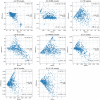A comprehensive accuracy assessment of Samsung smartwatch heart rate and heart rate variability
- PMID: 36480505
- PMCID: PMC9731465
- DOI: 10.1371/journal.pone.0268361
A comprehensive accuracy assessment of Samsung smartwatch heart rate and heart rate variability
Abstract
Background: Photoplethysmography (PPG) is a low-cost and easy-to-implement method to measure vital signs, including heart rate (HR) and pulse rate variability (PRV) which widely used as a substitute of heart rate variability (HRV). The method is used in various wearable devices. For example, Samsung smartwatches are PPG-based open-source wristbands used in remote well-being monitoring and fitness applications. However, PPG is highly susceptible to motion artifacts and environmental noise. A validation study is required to investigate the accuracy of PPG-based wearable devices in free-living conditions.
Objective: We evaluate the accuracy of PPG signals-collected by the Samsung Gear Sport smartwatch in free-living conditions-in terms of HR and time-domain and frequency-domain HRV parameters against a medical-grade chest electrocardiogram (ECG) monitor.
Methods: We conducted 24-hours monitoring using a Samsung Gear Sport smartwatch and a Shimmer3 ECG device. The monitoring included 28 participants (14 male and 14 female), where they engaged in their daily routines. We evaluated HR and HRV parameters during the sleep and awake time. The parameters extracted from the smartwatch were compared against the ECG reference. For the comparison, we employed the Pearson correlation coefficient, Bland-Altman plot, and linear regression methods.
Results: We found a significantly high positive correlation between the smartwatch's and Shimmer ECG's HR, time-domain HRV, LF, and HF and a significant moderate positive correlation between the smartwatch's and shimmer ECG's LF/HF during sleep time. The mean biases of HR, time-domain HRV, and LF/HF were low, while the biases of LF and HF were moderate during sleep. The regression analysis showed low error variances of HR, AVNN, and pNN50, moderate error variances of SDNN, RMSSD, LF, and HF, and high error variances of LF/HF during sleep. During the awake time, there was a significantly high positive correlation of AVNN and a moderate positive correlation of HR, while the other parameters indicated significantly low positive correlations. RMSSD and SDNN showed low mean biases, and the other parameters had moderate mean biases. In addition, AVNN had moderate error variance while the other parameters indicated high error variances.
Conclusion: The Samsung smartwatch provides acceptable HR, time-domain HRV, LF, and HF parameters during sleep time. In contrast, during the awake time, AVNN and HR show satisfactory accuracy, and the other HRV parameters have high errors.
Copyright: © 2022 Sarhaddi et al. This is an open access article distributed under the terms of the Creative Commons Attribution License, which permits unrestricted use, distribution, and reproduction in any medium, provided the original author and source are credited.
Conflict of interest statement
The authors have declared that no competing interests exist.
Figures






References
-
- Stein P, Barzilay J, Domitrovich P, Chaves P, Gottdiener J, Heckbert S, et al.. The relationship of heart rate and heart rate variability to non-diabetic fasting glucose levels and the metabolic syndrome: The Cardiovascular Health Study. Diabetic medicine. 2007;24(8):855–863. doi: 10.1111/j.1464-5491.2007.02163.x - DOI - PubMed
Publication types
MeSH terms
LinkOut - more resources
Full Text Sources
Medical
Research Materials
Miscellaneous

